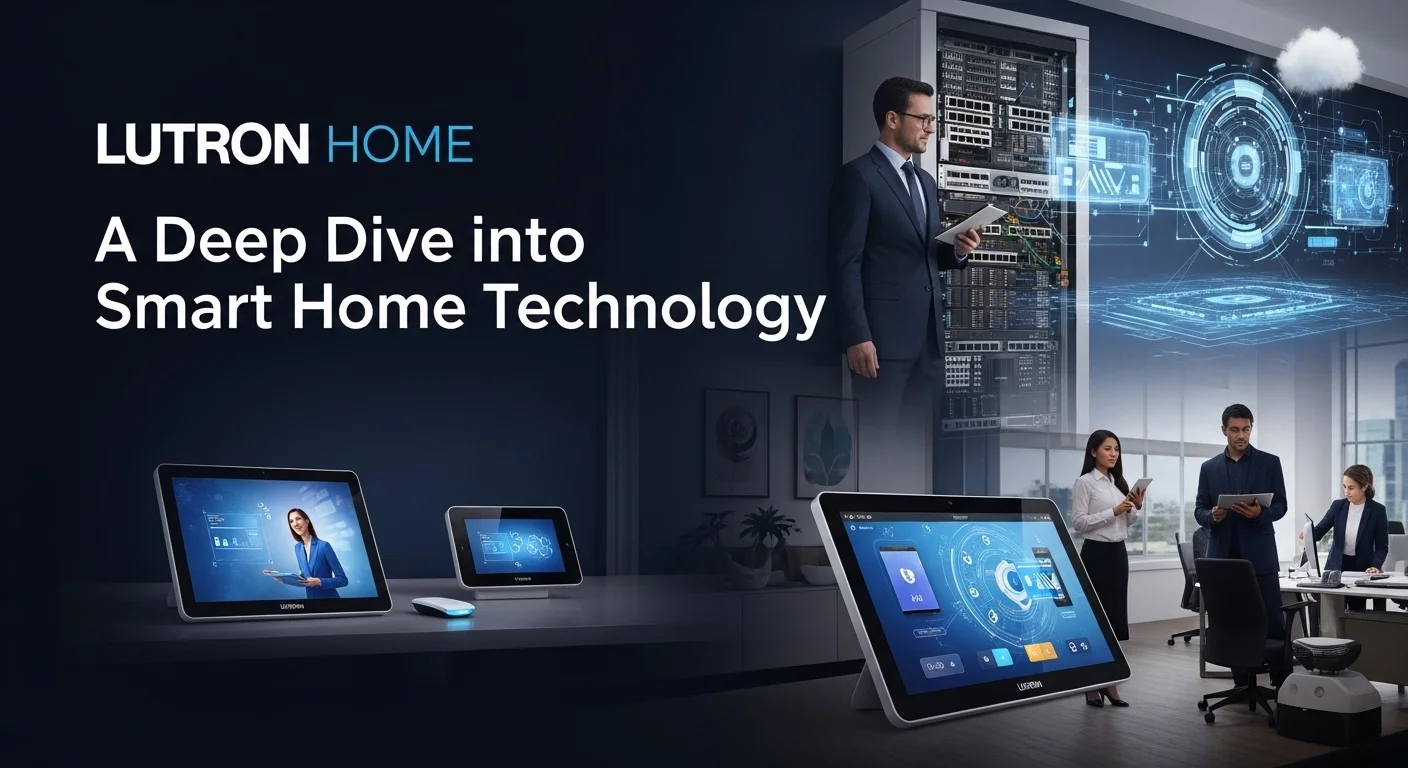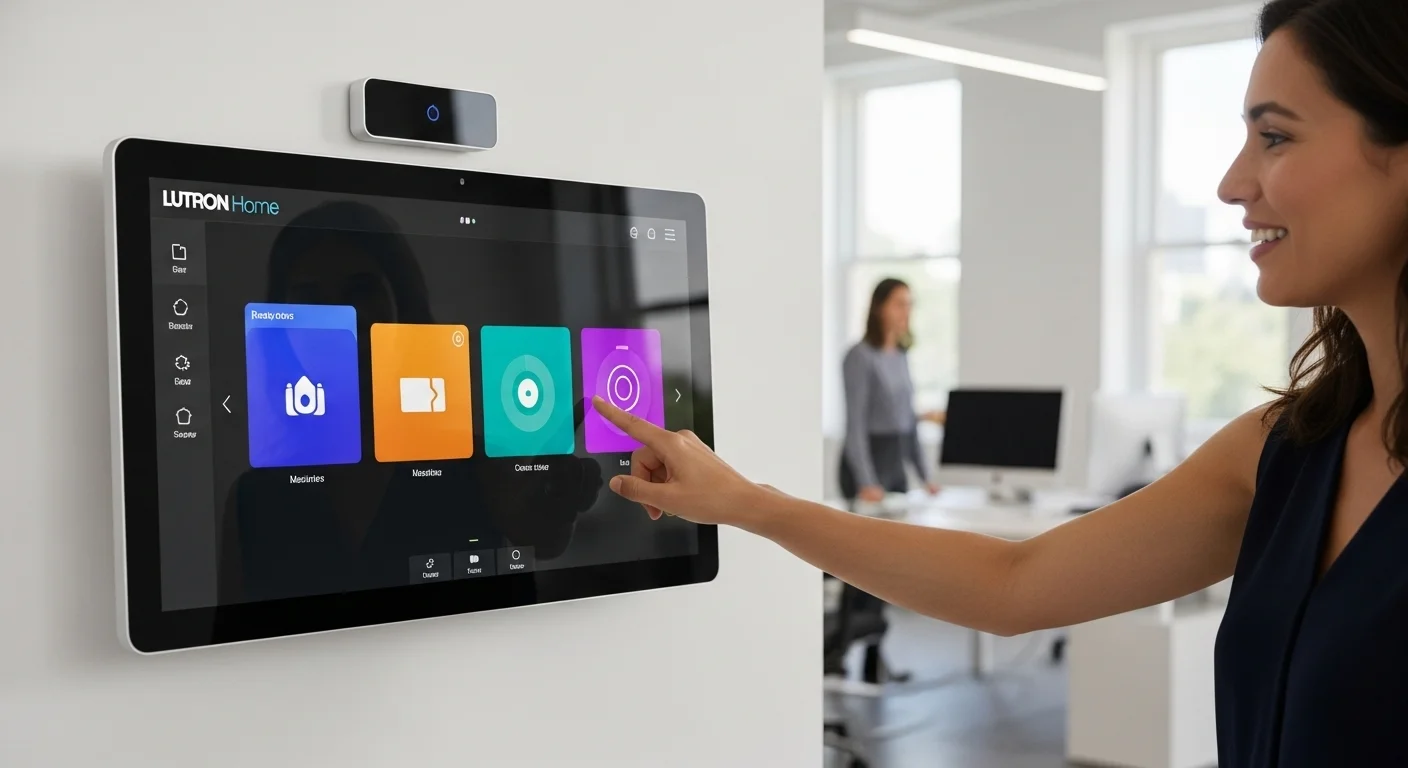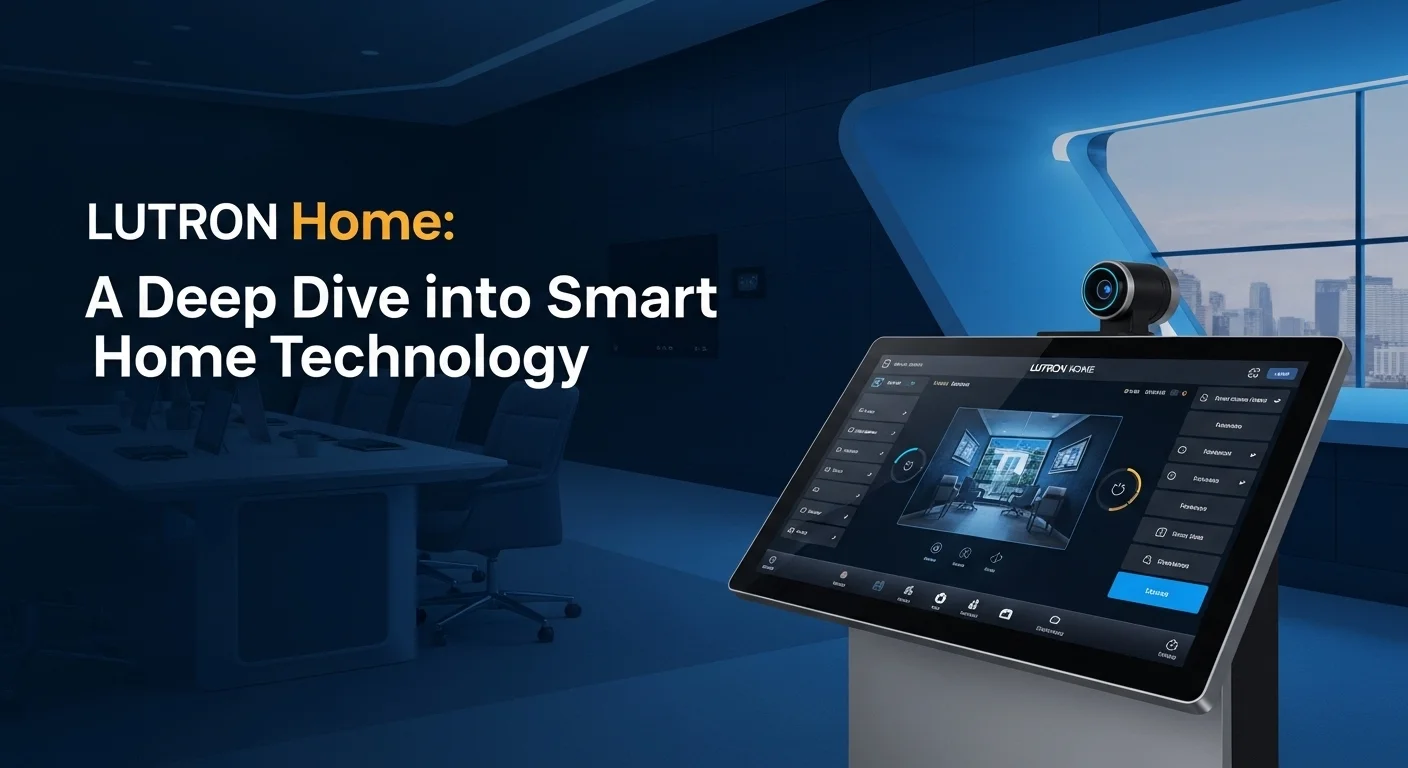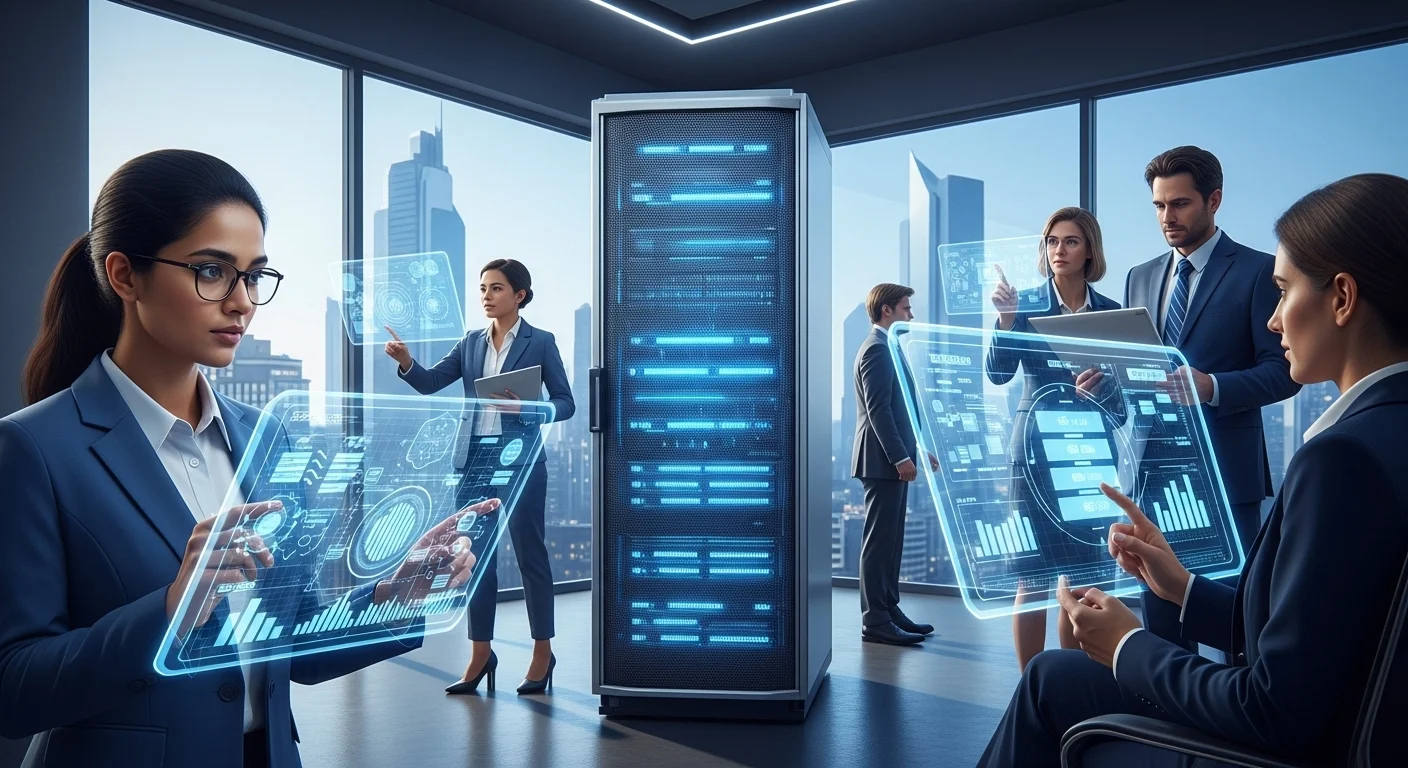Lutron Home Explained: A Pro's Guide to Smarter Living

Executive Summary
In my years of integrating smart home tech, one name has consistently stood for flawless performance: Lutron. It’s more than just a brand; it’s the gold standard for smart lighting and shade control. This guide is my deep dive into the Lutron world, built from hands-on experience. We'll explore why its Clear Connect RF technology is so incredibly reliable and look at its range of systems, from the accessible Caséta to the ultra-powerful HomeWorks. I'll share insights on how Lutron brings real benefits like comfort, energy savings, and security to your home. We'll also cover how these same principles can transform a business, boosting productivity and creating unforgettable customer experiences. Plus, we'll unpack the powerful partnership between Crestron Home and Lutron, the duo behind the world's most sophisticated smart spaces. This is the guide I wish I had when I started, perfect for anyone looking to truly understand the power of a premier smart home system.
Table of Contents
Table of Contents
- What is Lutron Home and Why Does It Matter?
- Lutron for Business: More Than Just a Smart Home
- The Crestron & Lutron Power Couple
- Under the Hood: How Lutron Technology Works
- Smart Business Moves: Using Lutron as a Strategic Tool
- Lutron vs. The Competition: Making the Right Choice
- Pro Tips for an Amazing Lutron Experience
What is Lutron Home and Why Does It Matter?
In our connected world, the idea of 'home' is changing. It's no longer just four walls and a roof; it's becoming a living, breathing space that responds to us. This shift is powered by home automation, and if you ask anyone in the industry, Lutron home automation is the bedrock of this revolution, especially when it comes to lighting and shades. For me, understanding Lutron is understanding the difference between a house full of gadgets and a truly intelligent home. It’s about moving from flicking switches to creating environments that deliver comfort, convenience, and efficiency without you even having to think about it.
Lutron’s story started back in the 1950s when its founder, Joel Spira, invented the world's first solid-state dimmer. His goal was simple: improve life with technology that also saves energy. That core idea still drives the Lutron smart home system today. While other companies try to do everything, Lutron has spent decades perfecting one thing: lighting and shade control. I've seen firsthand why this focus matters. In a home where your Wi-Fi is busy with streaming movies, video calls, and a dozen other devices, Lutron systems operate on their own private frequency, called Clear Connect. Think of it like a private, express lane on a congested highway. It means when you press a button to dim the lights, it just works—instantly, every single time. This bulletproof reliability is why I trust it in my clients' homes and in critical business settings.
The Foundation: Scalability and Rock-Solid Reliability
What makes Lutron so brilliant from a technology standpoint is that it can grow with you. They’ve created a family of systems, so whether you’re starting in a small apartment or building a luxury estate, there’s a solution that fits. It’s a huge plus for homeowners and businesses.
- Lutron Caséta: This is the perfect entry point. It’s my go-to recommendation for DIYers or for single-room projects. You get incredibly reliable control of lights, shades, and temperature from an app or your voice. It’s simple, but it’s built with that same reliable Clear Connect tech, so it’s a true taste of the Lutron home control system.
- RadioRA 3: This is where we step up to whole-home control and professional installation. RadioRA 3 is for larger homes and offers more design-focused keypads and expanded capabilities. It handles more devices and lets you create much more sophisticated automated scenes, taking your smart home to the next level.
- HomeWorks: This is the pinnacle, the system I install in high-end luxury homes and complex projects. HomeWorks is the ultimate Lutron home automation system, offering unmatched power and customization. It can control thousands of lights and shades and integrates flawlessly with virtually any other system you can imagine, from home theaters to advanced security. It’s the undisputed king of lighting control.
This tiered approach means you can start your journey with Caséta and, if you move or build later, you can graduate to a full HomeWorks system knowing you're getting that same core quality and reliability you've come to trust.
Lutron for Business: More Than Just a Smart Home
Don’t let the 'Home' in the name fool you; Lutron is a powerhouse in the commercial world. The same magic that creates a perfect movie night at home can have a massive impact on a business’s productivity and bottom line.
Saving Money and Being Green: Lighting is a huge expense for any business. Lutron systems give you powerful tools to cut those costs. I love setting up daylight harvesting, where sensors detect natural light and automatically dim the indoor lights. Occupancy sensors ensure lights turn off in empty offices or meeting rooms. It’s not just about saving money on the electricity bill; it’s about helping companies meet their sustainability goals, which is more important than ever.
Happier, More Productive People: The right light can make a huge difference in how people feel and work. Harsh office lighting is a drain on energy and focus. With a Lutron system, you can implement human-centric lighting, which subtly changes the light's color and intensity throughout the day to match our natural body clocks. This can boost alertness in the morning and help people wind down in the afternoon. Giving people keypad control over their own space with scenes like 'Presentation' or 'Focus' is a small thing that makes a big impact on job satisfaction.
Creating an Unforgettable Experience: For hotels, restaurants, and high-end retail, atmosphere is everything. Lutron is my secret weapon for crafting the perfect vibe. Imagine a hotel room that slowly brightens to welcome a guest, or a restaurant that transitions seamlessly from a bright lunch setting to a warm, intimate dinner mood. These automated details create a feeling of luxury and care that customers remember.
Seamless Integration: A modern business runs on many systems. A key strength of the Lutron smart home system is how well it plays with others, like HVAC, security, and AV systems. This allows for truly unified control. I often program a single 'End of Day' button that turns off every light, sets back the thermostat, and arms the security system. It simplifies everything and prevents costly mistakes.

Under the Hood: How Lutron Technology Works
A deep dive into the Lutron Home ecosystem reveals a world of sophisticated technology and strategic business solutions. Understanding the technical methods behind its renowned reliability, the business techniques for leveraging its power, and the resources available for implementation is key to unlocking its full potential. This guide serves as a comprehensive manual for IT professionals, business owners, and technology integrators looking to master the lutron home automation landscape and make informed decisions when comparing it to other industry players.
Technical Methods: The Engineering Behind Excellence
The magic of a Lutron smart home system isn't magic at all; it's just brilliant engineering. The secret sauce is Lutron's proprietary wireless technology, Clear Connect RF. While most smart gadgets fight for space on the crowded Wi-Fi highway (the 2.4 GHz and 5 GHz bands), Lutron built its own private, quiet lane. Clear Connect operates on a low-frequency band, which means it's not bothered by interference from your microwave, baby monitor, or a dozen other wireless devices. This is the simple reason behind Lutron's legendary reliability. When you press a keypad, the signal has a clear path and works every time.
Lutron has evolved this technology, creating different types for different needs:
- Clear Connect - Type A: This is the original, ultra-reliable workhorse found in systems like Caséta, RadioRA, and HomeWorks. It's known for its fantastic range and lightning-fast response.
- Clear Connect - Type X: Introduced with HomeWorks QSX and RadioRA 3, Type X is built for the future. It's designed to control more advanced fixtures like Ketra—Lutron's line of tunable, high-quality lighting—bringing even more performance and intelligence to the Lutron home control system.
The system's architecture is also designed for resilience. The 'brain' is a central processor, but the intelligence is also distributed to the individual keypads and dimmers. This means that even if the main processor were to fail (which is incredibly rare), the keypads in a room would still control the lights. It's a fault-tolerant design that's essential for any home or business where you just can't afford failure.
Speaking the Same Language: For integration with other systems like Crestron Home, Lutron uses a well-documented API. This allows the Crestron controller to 'speak' directly to the Lutron system. When a Crestron processor sends a command, it’s not going through the cloud and back; it's a direct, local conversation on your home network. This is why a Crestron Home Lutron system is so fast and stable—the two key players are sitting right next to each other, speaking the same language.
Smart Business Moves: Using Lutron as a Strategic Tool
For a business, installing a Lutron home automation system is more than an upgrade; it's a strategic investment. Here’s how I advise businesses to leverage it for a real competitive edge.
1. Create a Workplace People Love: Attract and keep top talent by creating a better place to work. I use Lutron's tunable lighting, like Ketra, to create dynamic environments. A 'Focus' scene in the morning with cool, bright light boosts alertness, while a warmer, dimmer 'Unwind' scene in the afternoon helps people transition out of work mode. This focus on well-being is a powerful tool in today's job market.
2. Automate Everything You Can: I start with an audit of the workspace. Which lights are always left on? Where do people complain about glare? Then we deploy sensors. Occupancy sensors in offices and restrooms, daylight sensors near windows, and a timeclock that shuts down all non-essential lights after hours. This automation removes the mental load from staff and ensures you're never wasting energy.
3. Reinforce Your Brand: For any client-facing business, the environment is a statement. I use lighting to tell a story. A 'Client Welcome' scene can create an impressive, welcoming path to a conference room. There, a 'Presentation' scene can dim the lights and focus attention with a single touch. This effortless sophistication tells clients you’re competent and pay attention to every detail.
4. Build for the Future: Modern offices need to be flexible. Since Lutron keypads are wireless, they can be moved and reprogrammed easily as a space's layout changes. A large open area can be rezoned without calling an electrician. This adaptability makes the initial investment in a Lutron home control system pay off for years to come.
Available Resources and Comparisons
Implementing an advanced Lutron system like RadioRA 3 or HomeWorks is a job for a pro. Lutron has built a strong support system for this.
- Certified Dealers: Lutron's global network of certified dealers is your best resource. We go through intensive training to become experts in design and programming. I always say, working with a certified pro is the best way to guarantee your system is perfect.
- Lutron Designer Software: This is the powerful tool we use to design and program your entire system virtually before we even touch a wire.
- Online Support: Lutron’s website is filled with great documentation, and they offer fantastic tech support to their professional installers. For DIYers using Caséta, the app and online community are very helpful.
Lutron vs. The Competition:
When clients ask me how Lutron stacks up, here's my honest breakdown:
- Lutron vs. Crestron: As I mentioned, this is more of a dream team. Lutron is the undisputed specialist in lighting and shades. Crestron is the master of whole-home control, especially complex AV systems, which Lutron doesn't do. I often design a Crestron Home Lutron system to get the best of both: Lutron's flawless lighting controlled by Crestron's powerful brain.
- Lutron vs. Control4: Control4 is another big player that aims to be a total home solution. Their own lighting is good and integrates tightly into their system. However, for projects where lighting and shades are the top priority, I still find that most clients and integrators lean towards Lutron for its specialized technology and reputation. The choice often comes down to the primary focus of the project.
- Lutron vs. DIY Brands (Philips Hue, etc.): Brands like Hue are great for getting started with smart lighting in a single room or for renters. But they are in a completely different league. They rely on your Wi-Fi and are controlled through an app, lacking the hardwired reliability, elegant keypad control, and deep integration of a professional Lutron home automation system. They’re a fun entry point, but not built for the demands of an entire home or business where reliability is everything.

Pro Tips for an Amazing Lutron Experience
Putting in a Lutron Home system is one thing; designing an experience that feels truly magical is another. Over the years, I've learned a few strategies that elevate a system from good to unforgettable. Here are my best tips for getting the most out of your lutron home automation, covering design, security, and making it a powerful tool for your life or business.
Best Practices for System Design and User Experience
The secret to a great Lutron smart home system is designing it around people and their daily activities. The goal is to make control so intuitive, it becomes second nature.
1. Think in Scenes, Not Switches: This is the biggest mental shift. Don't just turn on a light; create a mood. A button on a keypad shouldn't just turn on the island light. It should activate a 'Cook' scene: island light to 100%, under-cabinet lights to 75%, and the dining room dimmed to a soft glow. I design scenes for everything: 'Entertain,' 'Relax,' 'Movie Night,' 'Good Morning,' and 'Goodnight.' It’s simpler and far more elegant.
2. The 'All Off' Button is Your Best Friend: This is a must-have for every project. I put an 'All Off' button by the main doors and on the master bedside table. One touch gives you peace of mind that every light is off and you're not wasting energy. In a Crestron Home Lutron setup, that same button can also arm the security system and set the thermostat to 'Away'.
3. Keep Keypads Consistent: For a whole-home system, a consistent keypad layout is crucial. For example, I always make the top button the brightest 'On' scene and the bottom button 'Off.' This creates muscle memory, making it easy for family and guests to use the system without a single instruction.
4. Work with Natural Light: A truly smart home embraces the sun. I always incorporate automated shades into the initial design. Program them to open slowly in the morning and close in the hot afternoon to block heat and lower cooling costs. Using Lutron's daylight sensors, the system can even dim the lights automatically when the sun is bright enough, saving energy effortlessly.
5. Get Rid of Wall Clutter: One of my favorite benefits of a Lutron home control system is eliminating 'wall acne'—those ugly banks of four or five switches. A single, beautiful Lutron keypad can replace all of them. For the cleanest look, we hide the main dimmers in a utility closet, leaving just the sleek, elegant keypad on the wall.
Cybersecurity in the Connected Home and Business
Security is a top priority. A compromised lighting system could be a backdoor into your network. Lutron takes this incredibly seriously, and here’s how I ensure my clients' systems are rock-solid.
Strategy 1: Trust the Pros. Systems like RadioRA 3 and HomeWorks are closed loops installed by certified professionals. This itself is a security feature. The core system doesn't rely on the cloud to work, and the communication happens on Lutron's own secure frequency, not your Wi-Fi.
Strategy 2: Build a Strong Foundation. Your Lutron system connects to your home network for app control, so basic network security is essential. Use a strong, unique password for your Wi-Fi. For advanced users, I recommend setting up a separate network for all your IoT devices to keep them isolated from sensitive data on your computers.
Strategy 3: Integrate Securely. The Crestron Home Lutron integration is a perfect example of a secure partnership. Both systems are pro-installed and talk directly to each other on your local network, not over the internet. I always advise clients to be cautious about connecting to less reputable third-party services.
Strategy 4: Keep Firmware Updated. Lutron regularly releases updates to patch any potential security issues. Your dealer will typically handle this for professional systems, but for DIY systems like Caséta, make sure you enable automatic updates in the app. This keeps your Lutron home automation system protected from the latest threats.
The Role of AI and Future Technologies
The future of home automation is about the home anticipating your needs. AI is starting to make this a reality.
AI-Powered Voice Control: The integration with advanced voice assistants like Josh.ai is a game-changer. You can give complex commands like, 'OK Josh, dim the living room lights, close the shades, and play my dinner playlist.' Josh.ai also prioritizes privacy by processing commands locally. The new 'Josh.ai Ready Wallplate' even combines a Lutron keypad with a tiny Josh microphone for a completely seamless look and feel.
A Home That Learns: The next step is a home that learns your habits. An AI-enhanced Lutron smart home system could notice you always turn on the patio lights at sunset and start doing it for you. If it sees an early meeting on your calendar, it might gently raise your shades a little earlier. This predictive automation is where things are headed, and Lutron’s robust platform is the perfect foundation for it.
Business Tools and Maximizing ROI
For a business, a Lutron home control system is a tool with a real return on investment (ROI). To maximize it, I recommend:
- Energy Audits: Use the system to track energy data. Lutron's commercial platforms can generate reports showing exactly where you're saving money and where you can improve.
- Integration with Scheduling: In an office with 'hot desks,' the system can integrate with booking software. When someone books a desk, their light turns on. When they check out, it turns off. This granular control is a huge energy saver.
- Smarter Security: Go beyond just turning lights off. Integrate the system with security cameras. If motion is detected in a restricted area after hours, the system can flash all the lights in that zone—a powerful and effective deterrent.
By applying these strategies, you can transform a Lutron system from a set of convenient controls into the intelligent heart of a secure, responsive, and truly amazing space. For more technical details on integration, Crestron offers an excellent guide for pros: Crestron Home OS Integration Guide. This level of planning is what makes all the difference.
Expert Reviews & Testimonials
Sarah Johnson, Business Owner ⭐⭐⭐
As a business owner, I found the information on Lutron helpful, but I was hoping for more real-world case studies on how small businesses like mine can benefit.
Mike Chen, IT Consultant ⭐⭐⭐⭐
This was a solid overview of the Lutron ecosystem. It clarified the differences between the systems for me, though the section on APIs was a bit dense. Overall, very helpful for my consulting work.
Emma Davis, Tech Expert ⭐⭐⭐⭐⭐
An absolutely fantastic and thorough breakdown of Lutron! As a tech professional, I appreciated the depth. It covered everything I needed to know and explained the Crestron integration perfectly.



